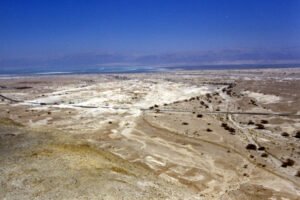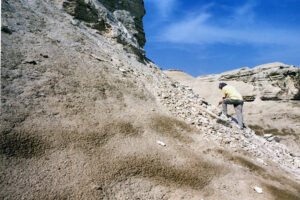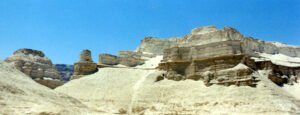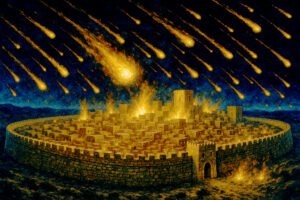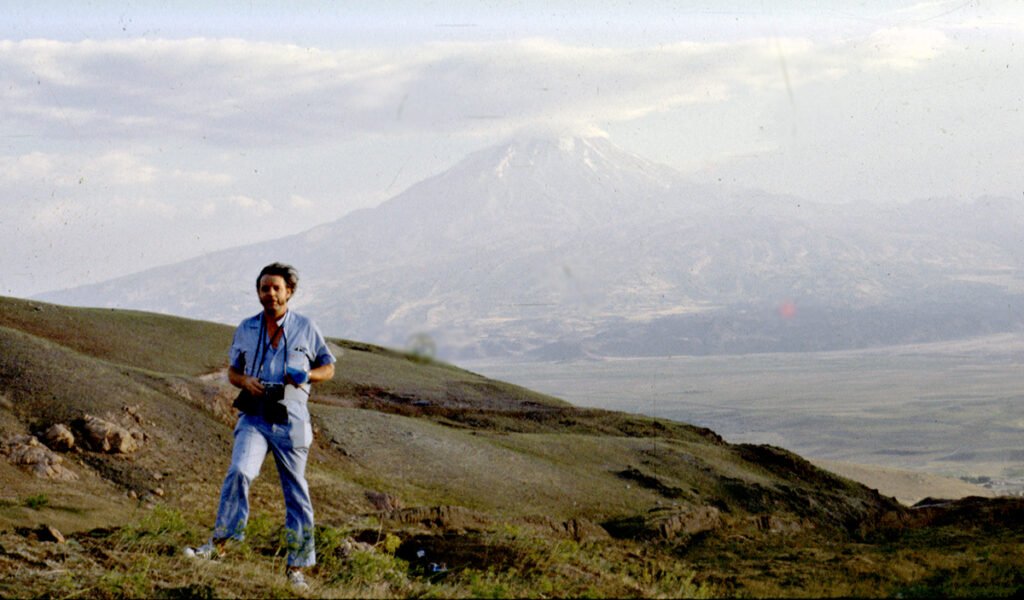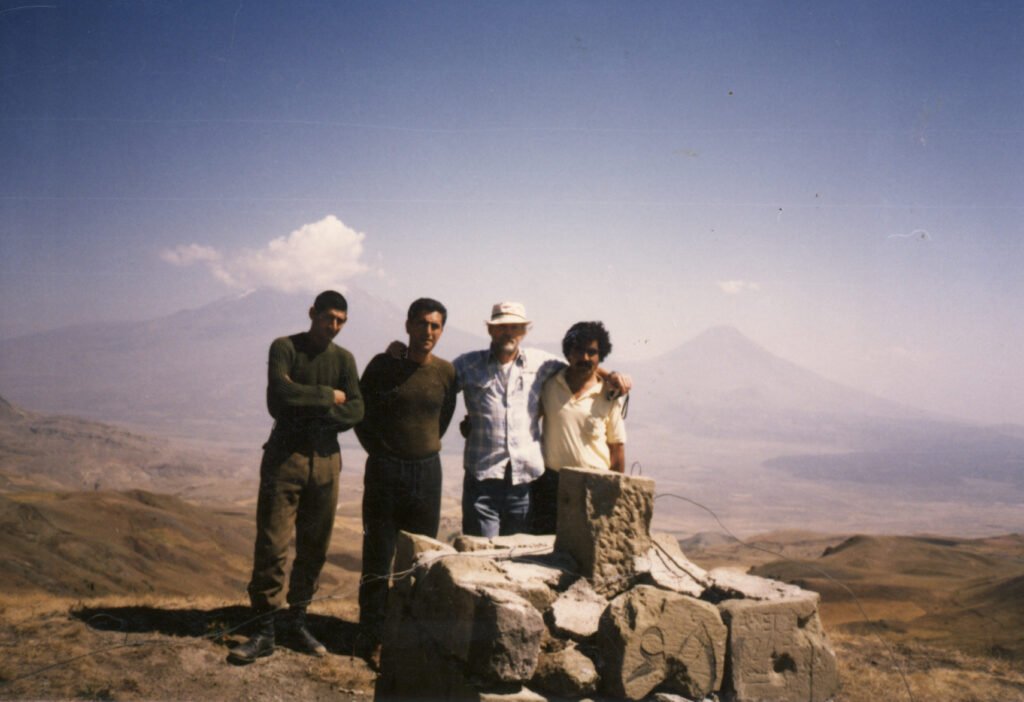The Beginning
The Beginning
Ron Wyatt grew up in the mountains of Kentucky in a large, poor, Bible believing family. Circumstances dictated that he had to leave home as a young teen. Fortunately, a family member was able to get him enrolled in a Christian boarding school in Tennessee. With no means to pay for his schooling, he was given responsibilities at the school such as maintaining the heating and other similar duties when school was not in session.
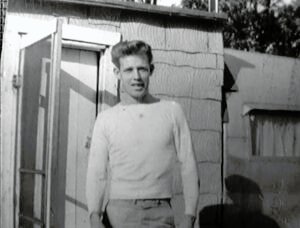
Ron had enlisted in the army when he left high school in order to take advantage of the GI Bill to fund his college education. His hope was to become a doctor.
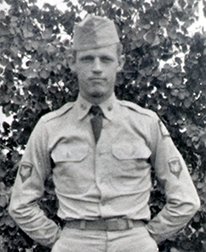
He then married and started his family. Working as a lab technician in the quality control lab at Hercules Powder Plant in Kalamazoo, Michigan, he was also attending Western Michigan University, studying pre-med.

VIDEO: Ron, how did you get interested in archaeology?:
Discovery of a Strange, Boat-Shaped Formation in Turkey
In 1960, 27 year old Ron Wyatt, along with thousands of other people, read an article in Life Magazine about a strange boat-shaped formation in the mountains of Ararat:
"NOAH"S ARK?
Boatlike form is seen near Ararat.
“While routinely examining aerial photos of his country, a Turkish army captain suddenly gaped at the picture shown above. There, on a mountain 20 miles south of Mt. Ararat, the biblical landfall of Noah's Ark, was a boat-shaped form about 500 feet long. The captain passed on the word. Soon an expedition including American scientists set out for the site.
At 7,000 feet, in the midst of crevasses and landslide debris, the explorers found a clear, grassy area shaped like a ship and rimmed with steep, packed-earth sides. Its dimensions are close to those given in Genesis: `The length of the ark shall be 300 cubits, the breadth of it 50 cubits, and the height of it 30 cubits,' that is, 450x75x45 feet. A quick two-day survey revealed no sign that the object was man made. Yet a scientist in the group says nothing in nature could create such a symmetrical shape. A thorough excavation may be made another year to solve the mystery."
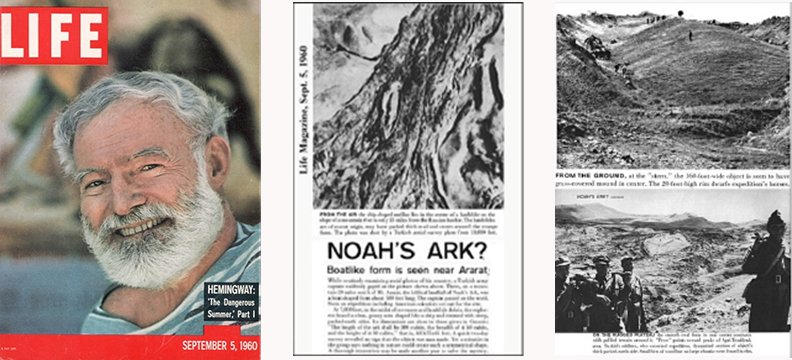
At the time Ron read the Life Magazine article, he determined that one day he would visit the site and see it for himself. But that was a dream he could scarcely realize any time soon. He had a 16 month old daughter, a 3 month old son, and within a year and a month, he would have another son.

But soon, family matters forced him to give up his hopes of becoming a doctor and he moved to Kentucky in 1964 where he entered nursing school. He graduated in 1967, entered Anesthesia School and graduated as a Certified Registered Nurse Anesthetist in 1970.
It was also in 1970 that he found himself raising his 3 young children alone. It didn't look like there would ever be any opportunity for him to visit the strange boat-shaped site, so he had to limit his archaeological research to libraries and book stores
Ron's Interest in the Boat-Shaped Object Never Wained
But he never lost interest in the strange boat-shaped object. In fact, he studied everything concerning ancient history and archaeology, not just subjects concerning Noah's Ark. He had found that there was very little information available on the subject of Noah's Ark, which convinced Ron more than ever that no serious research had ever been undertaken on the subject. Everything he had read was based on folklore and unsubstantiated claims, and all claimed sightings were in different locations.
Ron Moved to Hawaii
From 1973 to 1975, he and the children lived in Hawaii where he was able to study volcanoes first hand. This convinced him that if the ark had landed on the volcanic peak called Mt. Ararat, that it would have long ago been destroyed. Despite the fact that there are those who have written elaborate explanations of how the ark could have survived on the volcanic peak, within a few years, the eruption of Mount St. Helens would soon show that NOTHING could survive on a volcanic mountain such as Ararat. If the ark had ever been there, he concluded it would have long ago been destroyed.
Building Mountains
Moving back to the mainland in 1975, Ron decided that there was one form of research that he could do. He built a small boat model the same ratio as the ark as stated in the Bible, and then he built various "mountain" configurations in a lake.
By floating the model down the moving waters of the lake, he observed the boat's reaction as it approached the various shaped "mountains".
What he learned was that when the boat approached a simple peak extending out of the water, it simply floated around it, not approaching it or certainly not landing on it. This was the "lateral displacement" of obstructed gas or liquid flow.
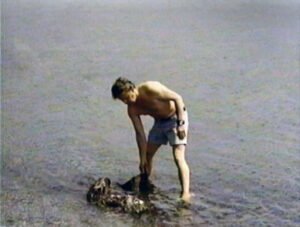
He continued this experiment with several shapes with the same result each time. That is, until he built a "crescent-shaped" formation with the crescent facing down-flow.
When the boat accelerated around this "crescent-shape" mountain, he saw that it was pulled into the area within the crescent by the "eddy" effect, where it then gently floated within that area. With this bit of information, Ron felt like the ark would have had to have landed on such a location.
VIDEO: Ron talks about building the configurations and his results:
Hydrodynamics and Where the Ark Could Have Landed
The laws of hydrodynamics and water action and reaction were the same then and now. If the ark had approached a mountain peak extending out of the water, the water displacement around the mountain would have carried the ark with it.
The study of water as a fluid, with its unique properties, and the study of hydrodynamics (fluid mechanics) and wave causation and motion is a most involved and complicated science. The actions and reactions of water and an object floating on that water cannot possibly be studied in depth here, but some simple rules must be understood.
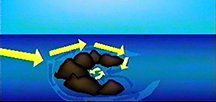
If a ship on the open sea approaches a mountain extending out of the sea or slightly below the surface, only one of two things can happen. One, the ship will be carried around the mountain with the lateral water displacement. Or two, the waves can be of such force and direction that they carry the ship right into the side of the mountain, with such force that the ship would break into pieces. But it would NOT come to rest on that steep mountain side. It just wouldn't happen.
And if that mountain peak were directly under the ship and the waters slowly descended, the ship still wouldn't land on the mountain side such as on Mt. Ararat. The water displacement and movement around the underwater mountain would still cause the ship to be removed from the mass of the mountain with the water.
The necessary criteria for a ship to land on a mountainside as sea waters descend would involve a process by which the water displacement would trap the ship within an area, such as an eddy could do.
Mount Ararat is a Recent Volcanic Mountain
Concerning Mount Ararat, the favored location for all the traditional ark hunters, it was determined by geologists to be a recent volcanic mountain. If this is true, it would not have even been in existence at the time of the flood and therefore not even a consideration for the landing site of the legendary ark.
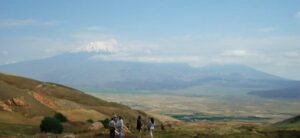
The evidence that it formed many years after the flood has been determined by the ancient tools found in the area. These tools, all made of obsidian, tell the story. Archaeologists studying the region and it’s artifacts discovered that all the obsidian tools in the Ararat region are composed of obsidian that does not match the composition of the obsidian produced by the volcanic Mount Ararat. Instead, their composition shows that they come from the Van region and it’s volcanic activity. Had there been obsidian in the Ararat valley region, they would have surely used that instead of having to travel quite far to get it.
The Size of the Ark- the Royal Egyptian Cubit
One of Ron's favorite subjects of study was the ancient Egyptians as related to the Biblical account. While in Hawaii, he had read everything he could get his hands on in the library. And as he mulled all the information over in his mind, there was one thing that seemed to be obvious to him- he knew that Moses had been the author of the Genesis account and therefore the flood story. As such, Ron believed that the cubit Moses would have known would have been the Royal Egyptian Cubit, the most universal standard of measurement in the ancient world at that time. This cubit equaled 20.62 of our modern day inches.
There was no Hebrew cubit in existence during Moses' time as there was no Hebrew nation. And to Ron, the “about 500” foot measurement given in the Life article was even more compelling evidence that the site needed thorough exploration. After all, 300 Royal Egyptian Cubits equals 515 feet, not the 450 feet commonly accepted and based on the future Hebrew cubit.
1975- Ron Reads the Ark File about the Original 1960 Expedition to the Site
It had now been fifteen years since he had read that Life Magazine article, but his interest never waned, it only grew. Then he read the book, "The Ark File" by Rene Noorbergen who just happened to be a member of that 1960 expedition to the boat-shaped formation. Until this time, Ron had no more information on the boat-shaped object other than what he had read in Life Magazine, but now he knew the names of the very men who visited it and the details of their expedition.

Mr. Noorbergen wrote of the expedition:
“Our days were crowded with solving logistical problems, traveling to Erzurum, and finally to Dogubayazit, a sleepy headquarters town of the Turkish Third Army, where we were assigned our army escort consisting of Major Baykal and fifteen foot soldiers. Baykal, a cavalry officer, abhored any other mode of transportation; consequently, we were borne by six of the meanest-looking horses into the rugged mountain terrain. Following Baykal, we ventured into the saddle region between Ararat and Tendurick, about twenty miles from the Iranian border.
My diary dated June 6, 1960, recalls the events:
‘It was 7:45 in the morning, when the major, who had galloped ahead of the first group, raised his arm and stopped the column on a gentle mountain slope. Tired and saddle sore, we dismounted. It hadn’t been a long ride- a few hours at the most- but everyone welcomed the change. It was quite a group, for much had happened since George and I had gotten together.
‘Here we were, a group of men representing a variety of professions. There was Dr. Arthur J. Brandenburger, one of the world’s foremost experts in photogrammetry and aerial photography; Captain Ilhan Durupinar, expert cartographer; Wilbur A. Bishop, self-made millionaire and one of the financiers of the expedition; George Vandeman, Protestant minister; Hal J. Thomsen, research assistant; and Dr. S. H. Horn, well respected archaeologist.’ (Dr. Horn did not share the enthusiasm of the others. He had little interest and still less faith in the ark project, and had accompanied the group reluctantly. After much urging.)
Major Baykal wandered away from us and looked at his maps. Then he turned and let his eyes scan the surrounding landscape. A feeling of disgust and dismay came over us, for no one felt this interruption was justified.
Suddenly the major shouted, ‘There she is men- there she is!’
Gone was all the disgust! We had expected to reach a volcanic area; in fact, all our expectations had been built on the statements of Durupinar and Professor Brandenburger who had said that the aerial photographs indicated that the object rested in a stream of lava. Yet, here we were amidst jagged mountains and gentle, sloping valleys- and this was it?
We looked in the direction he pointed, and there, across a greenish-brown valley lay the perfect image of a ship, nestled among the rocks. It certainly could not be a case of mistaken identity. It looked like a ship; yet somehow it didn’t fit the photographic study. Could this actually be the ark? All reports I had been studying these past years dealt with the ark being on one of the peaks of the mountains of Ararat, but this location was not only a great distance from the top, but it didn’t fit the mental image of what a petrified ship caught in a lava stream should look like. The thoughts that entered my head doubtless occupied the others, for during several minutes not a word was said.
I got my cameras in action and started shooting.
'Rene, what do you think of it?' George called out. 'It's so different from what I expected to find.' Keen disappointment showed on his face. Nervously he fingered his silvery hair. 'This doesn't seem to be it, and yet it fits the picture. It must be the same object.'
Professors Horn and Brandenburger joined us.
'Looks like a ship,’ Brandenburger commented.
'Yes, but where's the lava stream?' interrupted Hal Thomsen.
Climbing over rocks, crawling through crevasses and stumbling most of the way, we reached the earthen wall that had been identified on the aerial photograph as the probable side of the ship.
Out of breath, I crawled over the side and entered the object. At last! Gone was all the dreaming; finished was all the planning. We had reached the object, and the investigation could commence. I turned and watched the other expedition members climb 'aboard.' In depressing silence, all stood aghast at the difference between expectation and reality. While Brandenburger and Durupinar unpacked their field equipment, Dr. Horn scouted for the right spot for the first dig. With hand tools hurriedly borrowed from curious natives in a near village, the first trench was dug. The bits of dirt and stone that were thrown in our direction bore no resemblance to the expected petrified beams we had anticipated.
The dark gathering clouds that had been with us in Dogubayazit now began to cover the mountainside, reaching all the way to the summit of Greater Ararat, obscuring its shiny face from the intruders.
Time passed slowly, but no discoveries were made. Dr. Horn pointed out that we might be at the wrong spot.
'If these long heaps of dirt are formed this way because of the presence of an actual ship underneath,' he reasoned, 'then we should have come to it by this time. Nothing of any archaeological value has been discovered thus far. It doesn't seem right-'
A second trench was decided upon; this time digging from the inside toward the outside, but all this did was increase the unhappiness of the team. The 15-foot high side revealed nothing.
The next day's excavation probe did not reveal much more; however, the technique that followed was drastically different.
‘Let's try dynamite!’ Wilbur Bishop had suggested shortly before terminating the first day's probe, and the following day this was to be the predominant tactic. Needless to say, this was a decidedly unorthodox method for archaeological research, and the team's archaeologist strongly opposed this desperate maneuver. Conventional methods of excavation were adhered to until 11:45 a.m. To do a thorough job, a shaft should have been dug in the center of the object, while two trenches, one crosswise, another lengthwise, should also have been made. The lack of an actual excavation permit did not allow us to follow that course of action; therefore, at the right side of the bow, the second hole was enlarged and nine sticks of dynamite were inserted. One fuse and l 3⁄4 minutes later, the sticks of 1935-vintage explosives blackened the dirt with a tremendous explosion. Again, all that was found was dirt, rocks, and more dirt. No ark.
It was 12:12 p.m., June 7, 1960, when the excavation officially ended.
‘Let’s go home, folks,’ George Vandeman suggested after he had climbed out of the latest hole. ‘It's finished.’
It was a discouraged and sorrowful heap of humanity that walked down the slope that day, back to the spot where the horses waited. Two days later we were back in Ankara where the expedition was pronounced finished, and the following news release was issued to the assembled journalists:
‘SCIENTIFIC TEAM INVESTIGATES BOAT-SHAPED OBJECT IN EASTERN TURKEY’
With the full permission of the new government, an investigative team sent to eastern Turkey by the Archaeological Research Foundation of Washington, D.C., has just returned to Ankara after completing its study of a large boat-shaped object that appeared in an aerial photograph made by the Turkish army.
The team under the leadership of Mr. George Vandeman, located the object twenty miles south of Mount Ararat near the Iranian border. Captain Ilhan Durupinar of the Turkish cartographic service, who originally discovered the peculiar shape in the aerial photograph, was a member of the group.
Dr. Brandenburger, photogrammetry expert of the Ohio State University, foremost member of the team, stated, ‘Our measurements in the field verify our laboratory findings. In my opinion further study of this peculiar symmetrical phenomenon should be made by an expert in tectonics.’
The team found a landslide on a gentle mountain slope. Earthen walls within the slide were apparently pushed into the shape of a boat. There were no visible archaeological remains.
Mr. Vandeman concluded that the ‘mission was scientifically successful. We located the site and made our measurements. We identified the supposed object and ascertained to our satisfaction that it was a freak of nature and not man-made. It is of no further interest to use, so we shall not send an archaeological expedition into the area.
Officially it was all over, but the group was divided as to whether we should have gone on. In a ‘Confidential Report’ to backers and members of the expedition, George Vandeman admitted: ‘It is possible, however, that our own conclusions at the time were more negative that they should have been. Some in the group are not convinced that we have fully explored the possibility that something may be buried beneath the site that may have caused that portion of the earth to remain so symmetrical and boatlike a formation. Dr. Brandenburger writes me under date of June 24, (1960):
‘'Meanwhile I have received my developed colored slides of the ship-shaped formation, and I still must say it is an amazing feature. In any case it will be very difficult to explain its existence from the geological standpoint.
I showed the slides to some of my friends, and they were of the same opinion. It is doubtless a mystery, and I come always more to the conclusion that our official statement to the press was too negative. The interpretation of the formation is of utmost difficulty, and I am not anymore so sure that, from a serious scientific standpoint, a sole surface archaeological investigation of only two days entitles us to state that the formation is not the ark.’
But it was all finished; the dream of a million-dollar expedition was all over. In a series of unsuccessful attempts, it had been just another try to find the most celebrated artifact of ancient history.
It failed, but the search continued.
(The Ark Files, by Rene Noorbergen, copyright 1974, published by Pacific Press Publishing Association, pps 124- 129)
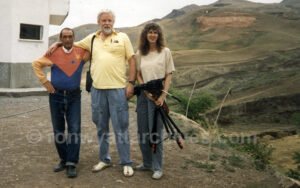
Welcome to the Ron Wyatt Archives. I'm Mary Nell (Ron's wife) and this site will attempt to fully document Ron Wyatt's work and discoveries. This website will be an ongoing project to document his work on all his various discoveries. Please check back often as new things will be added constantly.
| READ MORE |



